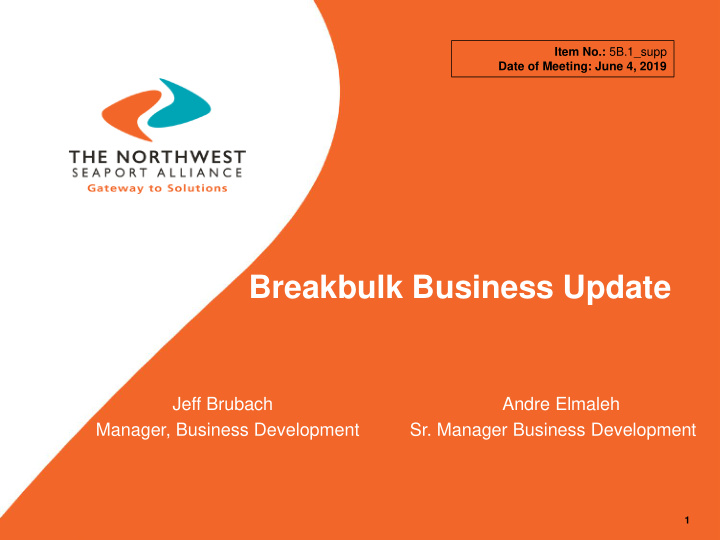



Item No.: 5B.1_supp Date of Meeting: June 4, 2019 Breakbulk Business Update Jeff Brubach Andre Elmaleh Manager, Business Development Sr. Manager Business Development 1
Breakbulk Business Overview Breakbulk is a core part of the Northwest Seaport Alliance (NWSA) business portfolio. Both harbors have been handling this cargo since their inceptions. Breakbulk business compliments other NWSA business and adds to the economic vitality of the region, while creating a significant number of diverse jobs. What is Breakbulk? Breakbulk is cargo that either cannot fit, or isn’t efficient to ship in containers, nor is it large quantities of unpackaged cargo in either liquid or granular form (bulk cargo). Examples of Breakbulk Cargo Include: Agricultural/Mining/Construction equipment, Modules for energy projects, Tram Railcars 2
Current Breakbulk Handling Facilities East-Blair 1 (EB-1) Terminal Features • 18 acres • Pier strength: 1,000 psf with 2,000 psf heavy lift section * • On-dock Rail * • Dedicated professional customer service group • Near-dock processing facility for high and heavy cargo • Easy access to I-5 for truck cargo * * Critical breakbulk facility feature 3
Current Breakbulk Handling Facilities Terminal 7 / Blair Terminal Features • Used for military cargo and breakbulk overflow • Available covered storage • Near-dock rail access • Easy access to I-5 for truck cargo * * Critical breakbulk facility feature 4
NWSA Breakbulk Customers...Who Are They? Ocean Carriers: Carriers have direct relationships with ports and guide customers to gateways that best meets their needs. Beneficial Cargo Owners: BCO's have influence over port selection and work with carriers to create low-cost, quality supply chains. 5
NWSA Breakbulk Customers (continued) Freight Forwarders: Forwarders secure end-to-end supply chain details for customers completing large projects or moving single pieces of cargo. Engineering Procurement Construction Companies: EPC's perform all services for specific projects, spanning from design to site delivery. 6
Top NWSA Non-Container Commodities 1. Machinery/Construction Equipment 170,578 MT (2018) 2. Agriculture Equipment 3. U.S. Military 23,978 MT (2018) 16,501 MT (2018) 7
NWSA: U.S. Military Strategic Ports • The Port of Tacoma serves as a strategic seaport. • The Port of Seattle serves as an alternate strategic seaport. • The NWSA relationship allows both ports to work cohesively in times of national emergency to serve both military and commercial customers. • The NWSA handles 2-3 U.S. Military outloads per year. 8
International Markets Served NWSA Breakbulk Volume: 20% 80% Import Export • Top Countries of Origin • Japan • Korea • Belgium • Top Countries of Destination • Japan • Belgium • Panama 9
NWSA Breakbulk Tonnage Trend 10
NWSA Breakbulk Cargo Trends Number of Pieces Handled 18,000 16,000 14,000 12,000 10,000 Import 8,000 Export 6,000 4,000 2,000 - 2016 2017 2018 11
Breakbulk Market Trends • Near-sourcing of project cargo • Containerized shipment of breakbulk equipment (SKD) • Shipping on flat racks via container vessels Breakbulk Market Key Drivers • Renewable energy project demand • Housing/construction market shift to "modulization" • Increased demand from emerging markets • Project cargo requirements 12
NWSA Competitive Advantages • Geographical proximity to Asia • Experienced labor force • Dual Class 1 rail service • NWSA customer service team support • On-dock rail at breakbulk facilities • Served by most major Ro-Ro ocean carriers • Heavy-lift capability • Service to Canadian markets 13
Competitive Landscape Pacific Northwest Breakbulk Market Share (measured in metric tons) Bellingham Portland, OR Longview 3% 2% 5% • Import: 42% (1) Kalama NWSA 9% • Export: 44% (1) Vancouver, WA • Total: 43% (1) Kalama NWSA Longview 43% Bellingham Portland, OR Aberdeen Everett Anacortes Olympia Vancouver, WA 37% Source: 2017 PIERS data 14
Competitive Landscape U.S. West Coast Breakbulk Market Share (measured in metric tons) Oakland Los Angeles 7% Los Angeles 30% NWSA • Import: 15% (2) Vancouver, WA • Export: 14% (2) San Francisco Long Beach • Total: 15% (2) Long Beach 11% Oakland Kalama Vancouver, BC Stockton San Francisco Longview 12% NWSA 15% Vancouver, WA 13% Source: 2017 PIERS data 15
Competitive Landscape U.S. Breakbulk Market Share (measured in metric tons) Charleston NWSA Galveston 3% 2% 4% Houston 21% Houston Baltimore 4% Mobile • Import: 2% (15) S. Louisiana Philadelphia 5% New Orleans • Export: 3% (12) New York • Total: 2% (13) Los Angeles Corpus Christi 5% Brownsville Los Angeles Mobile Brownsville 5% 14% Philadelphia Baltimore Corpus Christi Galveston 6% Charleston New York NWSA 6% S. Louisiana 12% New Orleans 12% Source: 2017 PIERS data 16
NWSA Breakbulk Commercial Strategy • Actively manage and grow key customer relationships • Represent NWSA with targeted customer outreach at industry events • Align stakeholders to fulfill needs of key customers and increase volume through NWSA gateway • Strategic use of social media to promote NWSA breakbulk advantages has translated to new business 17
Financial Overview Military and RO-RO Revenue $12,000,000 $10,000,000 $8,000,000 $6,000,000 $4,000,000 $2,000,000 $- 2016 2017 2018 2019 Budget 2019 actual (Estimated) EB1 T7 18
NWSA Supported Breakbulk Jobs • Rail Transportation: 1,690 • Truck Transportation, Logistics, Warehousing: 1,100 • Maritime Support Services: 440 • Navigation Services: 340 • Government: 200 • Terminal Operations, Stevedoring, Longshore: 110 Source: 2019 NWSA economic impact analysis 19
Conclusion • Breakbulk has a rich history in Tacoma and Seattle with a bright future ahead. • Breakbulk is a key component of the NWSA's diversified business portfolio. • Unique in operation and customer base, breakbulk operations are a significant source of jobs. 20
Recommend
More recommend